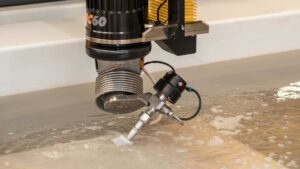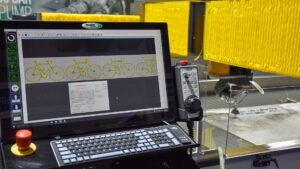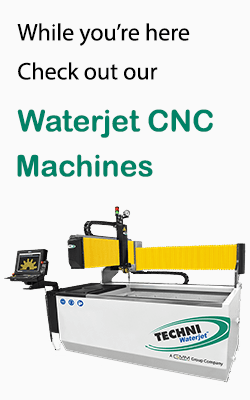Using abrasive waterjet cutting is a great development for the modern electronics industry. Waterjet has pushed the limits on what can be done, how fast it can be done, and how accurately it can be done.
Many professionals often have questions about applying waterjet cutting for manufacturing electronic components. This article will explore the use of waterjet cutters for the electronics sector.
Waterjet Cutting Overview
Waterjet cutting is a cold cutting process that works by erosion of material with high-pressure water. The water is focussed into a narrow beam with focussing tubes and a nozzle. This narrow beam can cut hard and soft materials with ease. Abrasive materials are added to the water when cutting harder materials like metals and alloys. The resulting process is called abrasive waterjet cutting.
Waterjet cutting has a lot of benefits over other alternatives like laser cutting. These benefits have made waterjet cutting suitable for many industries like aerospace, medical, dental, agriculture, defense, paper, furniture, construction, and automotive.
How Does the Electronic Industry Use Waterjet Cutting?
The electronics industry uses waterjet cutting in several areas. The frame of electronic devices like smartphones, laptops, TV, etc., are made with a waterjet cutter. Waterjet cutters find extensive use in semiconductor manufacturing. Processes like water dicing and edge grinding are common in semiconductor making. The metals used in the electronics industry are also cut with a waterjet.
The ability to make custom cuts with a waterjet finds use in R&D sector and DIY electronics projects. Waterjet can also create complex internal cuts. This enables the manufacturing of parts with secondary assembly.
What Materials Does Waterjet Cut in the Electronics Sector?
Waterjet works on a number of materials in the electronics sector. Some of these materials are:
Aluminum
Aluminum is one of the most used materials in the electronics sector. It is commonly used for making frames for smartphones and laptops. Many other parts, like power lines and antennae, are also made with aluminum. A water jet can cut aluminum pieces with extreme precision for these applications.
Copper
All conducting lines in electronics are made with copper plates. Copper is also used for cooling systems. All these applications create a demand for waterjet cutting of copper.
Lithium
Lithium is used for making batteries in electronic components. The amount of lithium for this purpose is very small per application. Very few cutting processes like waterjet can deal with working on this scale. Waterjet has a tolerance of +/- 0.001″.
Titanium
Titanium has a very high strength-to-weight ratio. Therefore it is used for making bodies for electronic components while keeping the overall weight down. Conventional cutting methods wear out faster when machining titanium. However, waterjet easily cuts titanium since it does not require physical cutting tools.
Silver
SIlver is used in a lot of electronic applications. Touch buttons in microwaves and other electronic appliances are made with silver. Silver is also used in TV screens and printed circuit boards (PCBs). The thickness of silver in these applications is extremely narrow. Waterjet cutting is able to cut silver to these exact specifications.
Gold
Gold is used in electronics for electroplating, bonding wire, and other purposes. Large portions of gold are cut with a waterjet to very minute thickness. It is then used for further applications.
Nickel
Nickel is commonly used for making plates in batteries. It also makes other parts like transistor electrodes and plater bars. Again, the small scale of manufacturing makes waterjet a perfect fit for nickel cutting.
Plastics
The electronics sector uses a wide range of plastics to make housing of components and boards. These plastics are high strength and don’t suit well with hot cutting processes. Waterjet cutting is the ideal way to cut these plastics.
Applications of Waterjet Cutting in Electronics
The above section depicts that a wide range of materials are cut with a waterjet cutter. This leads to a vast application of waterjet in electronics. Some of these applications are:
Consumer Electronics
- Smartphones: Waterjet makes the casing of smartphones out of metals, alloys, and plastics. The internal components of smartphones like batteries and circuitry are also made with a waterjet.
- Laptops: Laptop bodies are made with high-strength plastics and alloys. For instance, Macbook bodies are made with an alloy of aluminum and magnesium. These materials are cut with a waterjet for extreme accuracy and consistency.
- Television: Waterjet is used for making many components of TVs. The display, TV body, and circuitry all utilize waterjet cutting.
- Audio Equipment: Audio equipment like speakers, home theater systems, and audio interfaces are made with a waterjet cutter. Waterjet can make speaker frames of wood, plastics, and composite materials.
- Automotive Electronics: Automotive electronic systems like GPS and digital interface are made with waterjet. Even the transparent display covering is made with waterjet-cut fiberglass.
- Digital Cameras: Camera lenses require a precise cutting method that can work at an angle. Waterjet fits the bill quite well. Other camera components like frame and internal parts are also made with the same technology.
- Miscellaneous: Many other consumer electronic products like calculators, DVD players, media players, camcorders, etc., use this cutting method.
Industrial Electronics
- Sensor: Parts like pressure sensors, sensor switches, infrared sensors, light sensors, etc.
- Medical Devices: Medical electronic devices include a range of equipment like a pacemaker, blood pressure monitoring systems, vitals monitor, etc.
- Telecommunication: Waterjet can create parts for large-scale telecommunication systems.
Advantages of Waterjet Technology in Electronics
The water jet cutting process brings several benefits to the electronics industry. These benefits are:
- Versatile: Waterjet technology works on a wide variety of materials in the electronics industry. It works well on harder and softer materials.
- High Quality: Components cut with a water jet have a smooth edge. Water jet edge eliminates the need for secondary finishing processes.
- Fast: Waterjet can cut multiple layers of material simultaneously.
- No Heat-Affected Zones: Waterjet is a cold-cutting method. This eliminates heat-affected zones from the workpiece.
- Accuracy: Water jet cutting process is one of the most precise options.
- Scalable: Waterjet technology works for making industrial tools and end-use industry. Additionally, it can create large aircraft blades as well as microscopic semiconductor wafers.
- Save Time: Cutting multiple layers of sheet metal together means that manufacturers can save much time.
Where to Find CNC Waterjet Cutting Machine?
Techni Waterjet is the leading supplier of waterjet systems globally. There are many different Techni Waterjet machines models to suit the manufacturer requirements. These machines are used many many key players in North America, Australia, Midde East, and the rest of the world. You get complimentary software along with the machine to control the operation. Additionally, features like underwater cutting facilitate the cutting process and improve results.
Endnotes
Waterjet cutting is the best cutting solution for raw materials in the electronics industry. These systems outperform traditional cutting methods on every parameter. In fact, waterjet systems are an integral part of everything from the aerospace industry to the semiconductor industry. Get in touch with Techni Waterjet to know which machine would suit your requirements.





